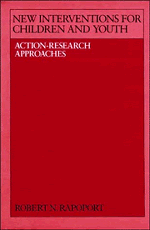6 - Conclusions
Published online by Cambridge University Press: 05 November 2011
Summary
The social interventions described in this book are of the intermediate type. They are neither at the large-scale (Type IV) program level, nor are they merely concepts (Type I), good ideas but untested in action. All involve the actualization of a new role or new group structure or small organization designed to help children or adolescents to develop coping capacities. Figure 6-1 locates the interventions in an ecological framework.
An understanding of the natural history of the case studies themselves and of other action programs operating in their fields underscores the point that the problems they address may be approached in various ways and at different levels. Having examined the cases in some detail, the three questions raised at the start of this book can now be discussed:
How do social interventions take form?
What are the issues in the use of action-research as a method for developing social innovations?
What do these action-research projects contribute to scientific knowledge about children's coping capacities?
Formation of social interventions
In the introductory chapter the many similarities between the invention process in technology and in the social-behavioral field were noted.
- Type
- Chapter
- Information
- New Interventions for Children and YouthAction-Research Approaches, pp. 242 - 264Publisher: Cambridge University PressPrint publication year: 1987



